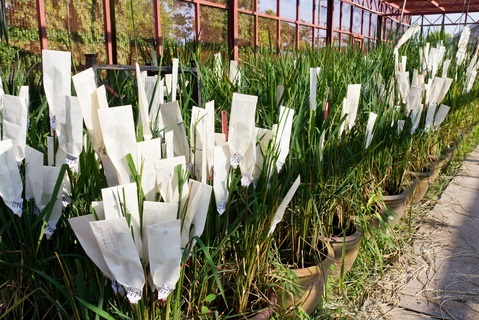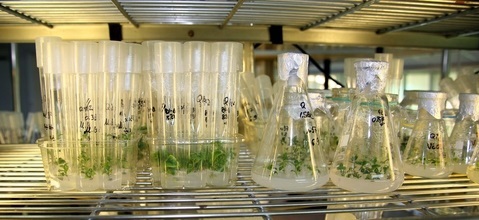
 Data Structure
Data Structure Networking
Networking RDBMS
RDBMS Operating System
Operating System Java
Java MS Excel
MS Excel iOS
iOS HTML
HTML CSS
CSS Android
Android Python
Python C Programming
C Programming C++
C++ C#
C# MongoDB
MongoDB MySQL
MySQL Javascript
Javascript PHP
PHP
- Selected Reading
- UPSC IAS Exams Notes
- Developer's Best Practices
- Questions and Answers
- Effective Resume Writing
- HR Interview Questions
- Computer Glossary
- Who is Who
What Is Transgenic Plant Breeding and How Can It Improve Crops
Introduction
Transgenic plant breeding is a technique that can be used to develop such crop varieties. With the increase in population and decreasing arable land, there is an urgent need to develop new and improved crop varieties that are more productive and resilient to environmental stresses.
In this tutorial, we will discuss what transgenic plant breeding is, how it works, and how it can be used to improve crops.
What is Transgenic Plant Breeding?
Transgenic plant breeding is a technique that involves the transfer of a gene from one organism to another.
In the case of crop plants, the goal is to transfer a gene that provides a desirable trait, such as resistance to pests or tolerance to environmental stresses, into a plant variety that lacks that trait.
The gene can come from any organism, including bacteria, viruses, fungi, animals, and other plants.
Transgenic plant breeding is different from traditional plant breeding, which involves crossing two plants with desirable traits to produce offspring with a combination of those traits.
Traditional plant breeding is a slow and unpredictable process that can take many years to produce a new variety.
Transgenic plant breeding, on the other hand, allows scientists to transfer a specific gene directly into a plant, resulting in a much faster and more precise process.

How does Transgenic Plant Breeding Work?
Transgenic plant breeding involves several steps ?
Identification of The Gene of Interest
The first step in transgenic plant breeding is to identify the gene that provides the desirable trait. This gene can come from any organism and can be isolated using molecular biology techniques.
Insertion of The Gene into A Vector
Once the gene of interest has been identified, it is inserted into a vector, which is usually a plasmid. The plasmid is then introduced into a host organism, such as bacteria, where it can replicate.
Transfer of The Gene into The Plant
The next step is to transfer the gene from the vector into the plant. This is usually done using a technique called Agrobacterium-mediated transformation. In this technique, the plasmid containing the gene of interest is introduced into a strain of bacteria called Agrobacterium tumefaciens, which is then used to infect the plant tissue.
Regeneration of The Plant
Once the gene has been transferred into the plant, the next step is to regenerate the plant from the infected tissue. This involves growing the plant tissue on a culture medium containing the nutrients and hormones needed for growth and development.
Selection of Transgenic Plants
After the plant has been regenerated, it is screened for the presence of the gene of interest. This can be done using molecular biology techniques, such as PCR, or by testing the plant's phenotype, or observable traits. Transgenic plants that contain the desired gene are then selected for further breeding and testing.

How can Transgenic Plant Breeding Improve Crops?
Transgenic plant breeding has the potential to improve crops in several ways ?
Increased Yield
Transgenic plants can be engineered to produce more biomass or to produce higher yields of specific products, such as fruits or seeds. For example, scientists have developed transgenic rice plants that produce up to 30% more grain than non-transgenic rice plants.
Resistance to Pests and Diseases
Transgenic plants can be engineered to be resistant to pests and diseases, reducing the need for pesticides and other chemicals. For example, scientists have developed transgenic cotton plants that are resistant to the cotton bollworm, a major pest that can cause significant damage to cotton crops.
Tolerance to Environmental Stresses
Transgenic plants can be engineered to be more tolerant to environmental stresses, such as drought, heat, and cold. This can help crops grow in areas that are not currently suitable for agriculture. For example, scientists have developed transgenic soybean plants that are more tolerant to drought, allowing them to grow in areas with limited water availability.
Improved Nutrient Content
Transgenic plants can be engineered to produce higher levels of certain nutrients, such as vitamins and minerals. For example, scientists have developed transgenic rice plants that produce higher levels of beta-carotene, which is converted to vitamin A in the human body. This can help address vitamin A deficiency, which is a major health problem in many parts of the world.
Reduced Environmental Impact
Transgenic plants can help reduce the environmental impact of agriculture by reducing the need for pesticides and fertilizers, as well as by allowing crops to be grown in areas that were previously unsuitable for agriculture.
Examples of Transgenic Plant Breeding in Action
Transgenic plant breeding has already been used to develop several crop varieties with improved traits. Here are a few examples ?
Bt Cotton
Bt cotton is a type of cotton that has been genetically modified to produce a protein called Bt toxin, which is toxic to certain pests, such as the cotton bollworm. This reduces the need for pesticides and has helped increase yields in cotton-growing regions around the world.
Golden Rice
Golden rice is a type of rice that has been genetically modified to produce beta-carotene, which is converted to vitamin A in the human body. This can help address vitamin A deficiency, which is a major health problem in many parts of the world.
Drought-Tolerant Maize
Drought-tolerant maize is a type of maize that has been genetically modified to be more tolerant to drought. This allows the crop to grow in areas with limited water availability, helping to improve food security in regions that are prone to drought.
Virus-Resistant Papaya
Papaya ringspot virus is a major threat to papaya crops around the world. Scientists have developed transgenic papaya plants that are resistant to the virus, helping to protect the crop and improve yields.
Challenges and Controversies
Transgenic plant breeding is not without its challenges and controversies. Here are a few ?
Safety Concerns
Some people are concerned about the safety of transgenic plants, particularly with regard to their potential impact on human health and the environment. While extensive testing is conducted before transgenic crops are approved for commercial use, some people remain sceptical.
Regulatory Issues
The regulation of transgenic crops varies from country to country, with some countries having more stringent regulations than others. This can make it difficult to develop and commercialize transgenic crops on a global scale.
Intellectual Property Rights
The development and commercialization of transgenic crops often involve complex intellectual property rights issues. This can create challenges for smaller farmers and seed companies, who may not have the resources to navigate these issues.
Conclusion
Transgenic plant breeding is a powerful tool that can be used to develop crop varieties with improved traits, such as increased yield, resistance to pests and diseases, and tolerance to environmental stresses.
While there are challenges and controversies associated with this technology, it has already been used to develop several important crop varieties and has the potential to help address some of the major challenges facing agriculture today.
With continued research and development, transgenic plant breeding could play an even larger role in improving global food security and sustainability in the future.

